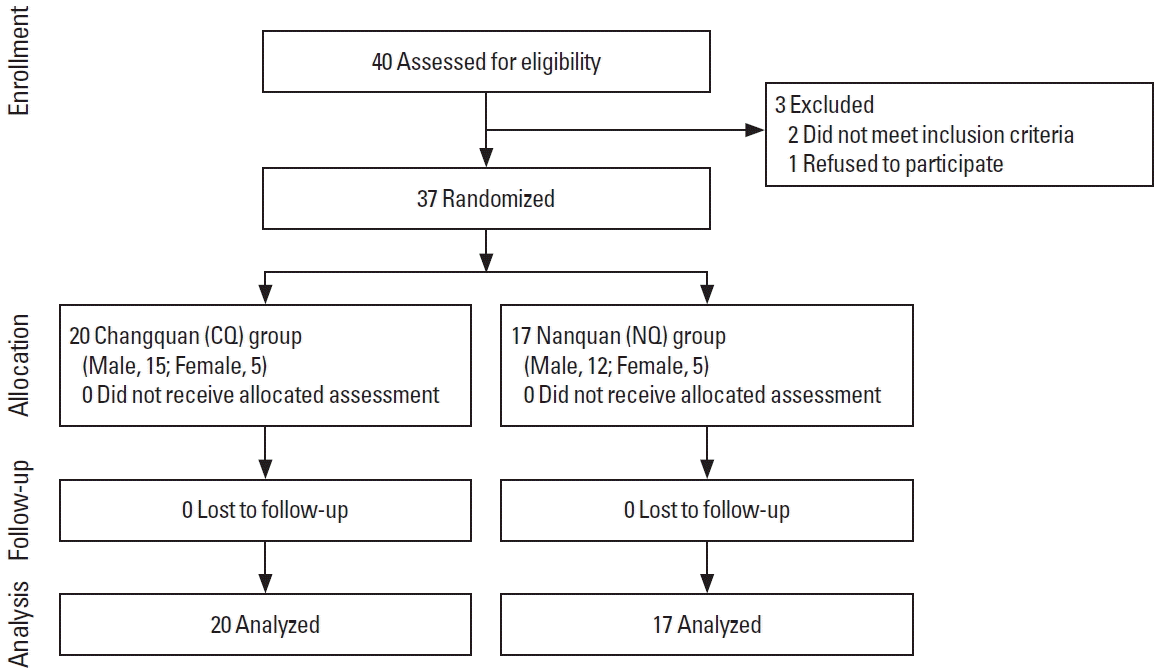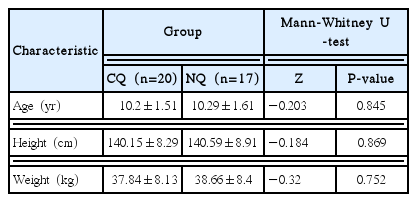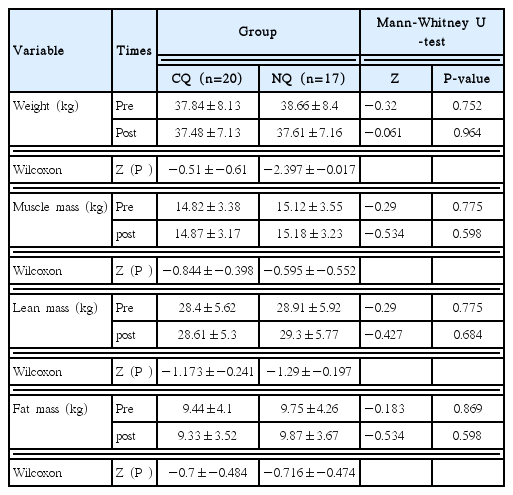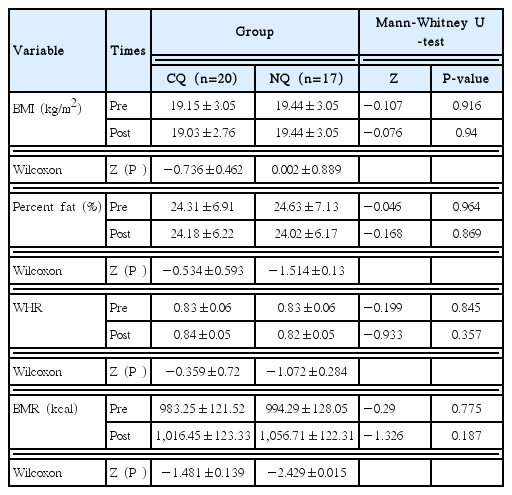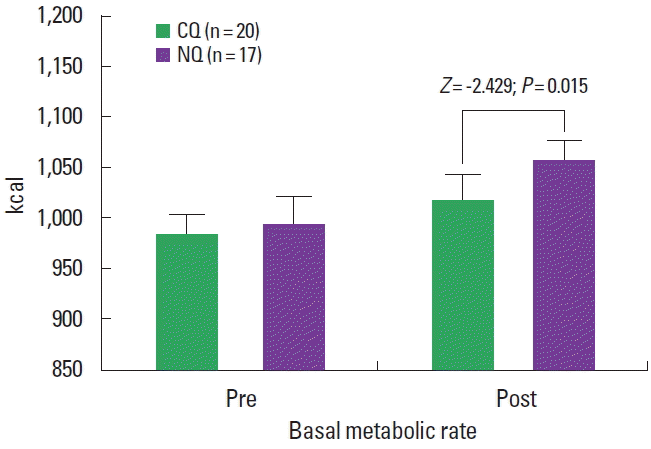Wushu Nanquan training is effective in preventing obesity and improving heart function in youth
Article information
Abstract
This study examined the differences of heart rate (HR) and body composition in elementary students who practiced two different styles of Wushu: Nanquan (NQ) and Changquan (CQ). A total of 40 subjects between the ages of 8 and 12 participated in this study who were grouped into NQ (n=20) and CQ (n=17). The results showed that the decreased body weight, increased basal metabolic rate, and higher physical efficiency index were due to the higher real-time HRs of NQ training compared with those of CQ training from 25 to 40 sec. Therefore, this study confirmed that Wushu NQ training can help to prevent obesity and improve heart function in elementary students.
INTRODUCTION
Although modern society allows for many comforts and conveniences, chronic diseases are more prevalent than ever before. Therefore, the development of treatment methods, as well as the need for prevention and management methods for social, mental, and physical problems are needed (Alley and Chang, 2007; Kuan and Roy, 2007).
At the present moment, there is much focus on the prevention of health problems through physical activity and proper management, which can relieve mental stress, reduce physical fatigue, and simultaneously enhance social emotions through interaction. In addition, it has been reported to improve cardiovascular and musculoskeletal growth and development for adolescents (Swallen et al., 2005). Recently, a sport-based martial art has been attracting attention as a way to prevent the health issues mentioned above. It is also known to reduce aggression, teach proper manners, and lead to a healthy lifestyle.
Wushu is a martial and a full-contact sport that originated in China. Over the years, it has evolved through the influence of the arts, literature, biological sciences, philosophy, ethics, and religion (McAnulty et al., 2016). It is now content-rich and is conducive to psychophysical health. It successfully became a globally recognized modern sport, as well as a health promoting form of physical activity with its unique competitive aspects and artistic expressions. Wushu consists of two events, which are classified as ‘taolu’ and ‘sansoo’ events. ‘Taolu’ events are composed of Tai Chi, Nanquan (NQ), and Changquan (CQ) while sansoo events consist of eleven weight classes for competition. CQ and NQ consist of taolu, which is a sequence of movement patterns that are excellent for cultivating body balance and stamina. CQ and NQ offer high social values such as improvement of health, willpower, cultivation of personality, and enrichment of cultural life (Tsang et al., 2010). For these reasons, CQ and NQ are the types of Wushu recommended for children to improve physical health and relieve mental stress.
Many Western sports activities are generally accepted and practiced by a great number of people, however martial arts has been considered as a luxurious form of sports. Moreover, although many Korean colleges and universities have accepted taekwondo and judo as professional sports and continue research on their validity, focus on Wushu has been lacking in many ways. In other words, although many comparative research studies regarding martial arts have been conducted on diverse martial art styles, the amount of research on Wushu has been limited. In particular, although CQ and NQ are taught to children in Wushu gyms, their characteristics and differences have not been studied.
To investigate training program design, the effects on heart rate (HR) was used to evaluate practice intensity. This study verified real-time HR responses during the practice of CQ and NQ forms of Wushu and studied the changes of body composition between CQ and NQ practitioners. The results of the study can provide educational material to promote Wushu as a national sport and assist front-line practitioners.
MATERIALS AND METHODS
Subjects
The subjects consisted of 40 students aged between 8 and 12 from an elementary school in Suwon, South Korea who had no experience of Wushu. The study was thoroughly explained to the students and guardians before the students voluntarily participated in the study after signing written consent forms. The protocol was approved by Sahmyook University Ethical Committee (SYUIRB2015-119). Of the 40 participants who completed the survey, three subjects were disqualified because two of them took part in a Tai Chi program and one of them refused to participate (n=3). The remaining 37 participants were randomly allocated to either CQ or NQ.
As shown in Fig. 1, all participants were randomly divided into one of two groups: CQ (n=20; male=15, female=5) and NQ (n= 17; male=10, female=5). The characteristics of the subjects are shown in Table 1.
Experimental protocol
All subjects were asked to perform the warm-up and cool-down exercises for 10 min before and after their training workout consisting of static and dynamic stretching exercises, and asked to perform the workout for 40 min. The CQ and NQ were composed of 40 sec per set, respectively. The trainings were checked with a portable heart monitor. The CQ and NQ trainings were conducted 3 days a week for 8 weeks. The prevalue measurements were compared with postvalues.
Assessment protocols
All participants were measured for their body composition and HR variables while performing either CQ or NQ. Specific procedures of the assessment protocols are as shown below.
Body composition measurements
BMS 330 anthropometer (BioSpace, Seoul, Korea) was used to measure height. Inbody 230 (Biospace) analyzer with the bioelectrical impedance analysis method was used for the body composition measurements. The participants were asked to remove all metal objects and anything else that might interfere with the electric stimuli, including socks, before stepping on the platform. They were also asked to grab onto the handles and stand still for 3 min. The participants abstained from food, exercise, and diuretic drinks 4 hr, 12 hr, and 7 days prior to assessments, respectively. The participants were also asked to void 30 min prior to the assessment (Cha et al., 2014; Han et al., 2016; Kim et al., 2015).
Real-time HR measurements during CQ and NQ
The participants were asked to sit and rest on a bench for at least 5 min prior to measuring their resting HR from the right radial artery for 10 sec. The reason for the manual measurement of the resting HR prior to using the portable heart checker was to observe and compare the error between two measurement methods. After the manual measurement, the HR variables were measured with the portable heart monitor while performing Wushu CQ and NQ. The HR changes while performing the CQ and NQ, including Harvard Step test, were measured using the Xcoach system (Spornix, Seoul, Korea). The Xcoach system receives the data transmitted from the wireless HR monitors while the automatic transceiver receives the data from a laptop. The HR checking sensors were placed and fixed around the center of the chest of the participants with a band. The sensors were synched with the receivers on a notebook to send the HR data every 5 sec.
Physical efficiency index via portable heart monitor
In order to observe the physically changes in CQ and NQ groups after 8 weeks, the physical efficiency index (PEI) was obtained by Harvard Step test using the same portable heart monitor. As for the Harvard step test, the participants were asked to step up and down for 5 min on a 50-cm high step bench. After completion, the recovery HRs were measured 3 times (1-1, 30 sec; 2-2, 30 sec; 3-3, 30 sec) to calculate PEI. PEI values (exercise time in sec×100÷added all recovery HR×2) less than 55 means ‘poor,’ between 55–64 means ‘below average’, 65–79 means ‘average’, 80–89 means ‘good’, over 90 means ‘excellent’ (Keen and Sloan, 1958; Treviño et al., 2008).
Statistical analysis
All data were recorded as mean±standard deviation. Kolmogorov–Smirnov test was used to verify normal distribution and degree of dispersion of the variables. In order to investigate the difference of variables between CQ and NQ, nonparametric Mann–Whitney U-test was used to investigate the changes of variables between pre and post values, as well as nonparametric Wilcoxon rank test. The significance level for all analyses were P<0.05.
RESULTS
Comparison of demographic factors
There were no significant differences in age (P=0.845), height (P=0.869), and weight (P=0.752) between groups as shown in Table 1. The above controlled variables showed no significant differences between both groups, indicating the homogeneity of this study.
Comparison of basic body composition
As shown in Table 2, there were no significant differences in weight (P=0.964) between CQ and NQ. Although the levels of weight (P=0.610) of CQ showed no significant differences between pre- and post-values, the levels of weight (P=0.017) of NQ showed significant differences after 8 weeks. However, there were no significant differences in muscle mass, lean mass, and fat mass between groups and between periods after the experiment.
Comparison of body fat levels
As shown in Table 3, there were no significant differences in body mass index (BMI), percent fat, and waist/hip ratio between groups and between periods after the experiment. Although there were no significant differences in basal metabolic rate (BMR) (P=0.187) between CQ and NQ, there were significant differences between pre- and postvalues of BMR (P=0.015) in NQ compared with no significant differences in BMR (P=0.139) of CQ after 8 weeks. These results are shown in Fig. 2.
Difference in PEI between CQ and NQ groups
As shown in Fig. 3, there were no significant differences in PEI between groups before the experiment. However, there were significant differences in PEI between periods after the experiment. Specifically, although the PEI of CQ had a baseline of 45.33± 6.36, there was an insignificant decrease to 45.27±5.77 after the experiment (Z=−0.421, P=0.674). However, the PEI of NQ significantly increased from 45.30±5.50 before the experiment to 46.31±5.69 after 8 weeks (Z=−2.666, P=0.008).
Difference of real-time HR during CQ and NQ training
The real-time HR variables observed during CQ and NQ training were expressed by mean and standard deviation with the statistical comparisons between the groups as shown in Table 4 and Fig. 4. The statistically significant differences were not observed during the course until three minutes of rest time in both Wushu performances. However, statistically significant differences were observed at specific time periods when the performance was classified into specific movements unique to the type of Wushu. In detail, the real-time HRs between CQ and NQ were significantly different at 25 sec (Z=−3.879, P=0.001), at 30 sec (Z=−2.202, P=0.049), at 35 sec (Z=−2.193, P=0.050), and at 40 sec (Z= −3.207, P=0.001), respectively. In other words, the values of NQ were significantly higher compared with those of CQ from 25 sec to 40 sec.
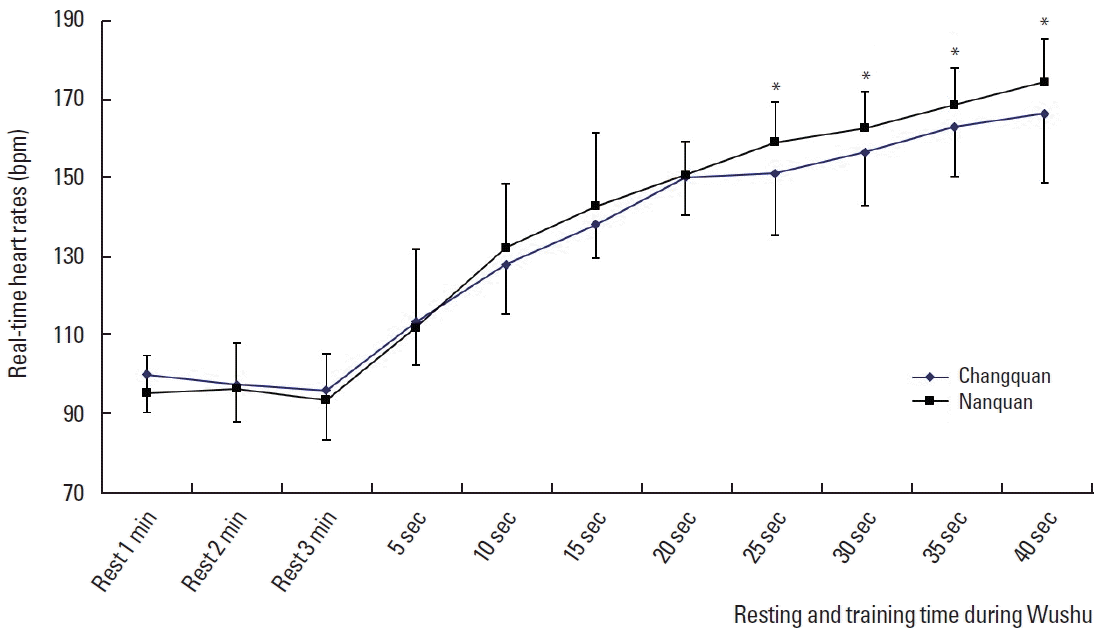
Differences and changes of real-time heart rate during Chanquan (CQ) and Nanquan (NQ). *Comparative results of heart rate analyzed by Mann-Whitney U-test.
In addition, the real-time HRs of NQ group reached 83.1% of the calculated maximal HR, whereas those of CQ group reached 79.2% of the maximal HR at 40 sec, indicating greater exercise intensity in the NQ group.
DISCUSSION
This study was conducted to observe HR changes and body composition variables of young participants while performing CQ and NQ of Wushu after 8 weeks. The results were as follows. Firstly, in regards to basic body composition, this study found that the body weight of CQ showed no significant difference, but that of NQ was significantly different. Secondly, when comparing body fat levels, there were no significant differences in BMR between CQ and NQ, however, there were significant differences between pre- and postvalues of BMR in NQ compared with no significant differences in BMR of CQ after 8 weeks. Thirdly, this study observed that there were significant differences in PEI between periods after the experiment. In other words, the PEI of CQ slightly decreased while that of NQ significantly increased after 8 weeks.
There are two distinct differences between CQ and NQ styles. CQ uses large unfolding motions that are characterized by fast, clear, and forceful movements. Fully extended kicks and strikes are emphasized along with circular movements to body mobility and balance. However, NQ employs mainly hand techniques and few kicks with movements that are tight, strong, and solid. Sharp waist movements and quick stance transitions are used to generate power and are also accompanied by vocal shouts. Although 8 weeks of training did not show significant differences in all values of body composition between both types of Wushu, BMI was greater in the NQ group in comparison to the CQ group. It was suggested that NQ movements have comparatively stronger movements with greater shouts during each movement to lead to greater HR and exercise loads, which in turn lead to greater energy expenditure such as increased BMR. Moreover, NQ training showed an increased PEI. We think that this increased PEI in NQ group was due to faster HR recovery in NQ than relatively slower HR recovery of CQ.
Generally, HR indicates the contraction frequency of the heart with a close relationship with the respiratory movements of the circulatory system (Nicolò et al., 2017). The load given to the heart has been generally used to indicate the objective intensity placed on the heart. The impulses received by the muscle spindles and joint capsule receptors during muscular activity are transmitted to the heart control receptors in the brain to increase HR (Takatani et al., 2018), and blood returned to the right atrium further increases body temperature and HR.
As physical activity continues, circulatory epinephrine and norepinephrine secreted by the adrenal medulla and sympathetic nerve endings increase to promote heart activity. In addition, chemical changes such as blood oxygen and carbon dioxide concentrations and pH stimulate the chemical receptors in the carotid body and aortic arc to send the afferent signals to the kinetic center of the heart to affect the activities of the heart. On the other hand, the amount of venous blood return increases during exercise to increase the discharge or firing frequency of the sinoatrial node, stimulated by the eccentric stimulations. In addition, increased activity of the cardiac muscle increases the excitability of the heart itself to further increase HR. Repeatedly increasing and decreasing HR through regular exercise lead to bradycardia of the heart. Such changes of the heart allow people who actively exercise to have lower increased HR during exercise and faster recovery after exercise than more sedentary individuals. This indicates activated metabolic function through higher cardiac function and positive effects on body composition including body fat through faster recovery to resting HR state.
In this study, although 8 weeks of Wushu CQ and NQ training did not alter the resting HR of the participants, statistically significant changes were observed between both groups during specific stages or periods of performance. In other words, significantly greater HRs were noticeably observed at 25 sec into the performance by the NQ group. Such differences were greatly observed at 30-, 35-, and 40-sec time periods. Such observations indicate that the exercise intensity is greater with the NQ than the CQ group since the exercise intensity increased as the movement performance progressed. Such results can be further supported by comparing the HRs at 40-sec time period with the measured maximal HR. The reason for such differences in the exercise intensity can be comprehended through the unique characteristics and differences of these two forms of Wushu. First of all, CQ movements are composed of large, wide, and flashy movements with leaps and acrobatic movements. On the other hand, NQ movements are composed of stable foot movements with strong upper body techniques with few kicks and jumps. Although both Wushu styles have techniques that are fast and strong with simple expressive movements, NQ requires stronger and more energetic movements with loud shouts which require greater exercise intensity for the subjects who participated in this study.
Meanwhile, healthy body composition is a critical factor for proper growth in youth. Body composition has become one of the many health-related physical fitness factors. With increased westernized diet and lack of exercise, the need for decreased body fat mass, increased lean mass, and proper body composition has become a greater issue for proper growth and health in children. Unlike adults, fat cells increase in number as well as in size during youth. Due to the increased fat cells, it becomes very difficult to return to normal weight by just exercise and diet alone when the children become adults. Moreover, the increased body fat mass and fat cells continue to stay into adulthood leading to adult related complications such as obesity, diabetes, and metabolic syndrome. Therefore, it is critical to prevent obesity by promoting regular exercise during youth.
Research by Artioli et al. (2009) studied physiological, nutritional, and performance profiles of 14 elite Olympic Wushu athletes. Olympic Wushu seems to be a highly anaerobic-dependent combat sport. Low body fat, high flexibility, anaerobic leg power, isometric strength, and moderately high anaerobic arm power seem to be important for competitive performances (Artioli et al., 2009). Therefore, many reports indicate that performing and training in martial arts significantly alter body composition. Practicing martial arts is especially helpful in reducing fat mass, which helps to prevent obesity and effectively promotes heath.
Regularly performing Wushu as shown in this study, leads to increased HR and greater exercise intensity to promote energy expenditure and reduction in body weight. Such changes can promote proper physical fitness and health management as well as effectively preventing adulthood complications in the long term. NQ’s strong movements will be especially effective in promoting these health benefits. Eventually, this study confirmed that these results such as decreased body weight, increased BMR and PEI were due to the higher real-time HRs of NQ training compared with those of CQ training from 25 to 40 sec.
The analysis and verification of the effectiveness of Wushu through the fields of exercise physiology and sports medicine seem critical to promote Wushu as a viable form of exercise. In other words, NQ training was especially effective in altering body composition due to increased exercise intensity toward the end of 40-sec routine movements. However, this study compared only two types of Wushu with simple 40 sec of repetitive movement programs. Limitations observed during this study should be complemented in future studies for more comprehensive and detailed results.
Notes
CONFLICT OF INTEREST
No potential conflict of interest relevant to this article was reported.
ACKNOWLEDGMENTS
This study was supported by the Research Grant of Howon University in 2018. We also convey our appreciation to those who participated in this study.

